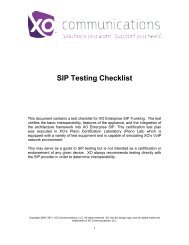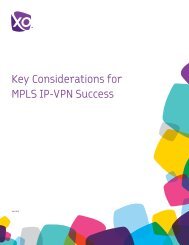VoIP for Dummies Book - XO Communications
VoIP for Dummies Book - XO Communications
VoIP for Dummies Book - XO Communications
You also want an ePaper? Increase the reach of your titles
YUMPU automatically turns print PDFs into web optimized ePapers that Google loves.
38<br />
<strong>XO</strong> <strong>Communications</strong> <strong>VoIP</strong> For <strong>Dummies</strong><br />
Videoconferencing solutions depend on the size of the enterprise<br />
and the type of videoconferencing application needed,<br />
such as point-to-point, multipoint, or desktop. The videoconferencing<br />
needs of a business can be met by using dedicated or<br />
switched transports that run physically apart from the data<br />
and voice networks. Or these needs can be met by using the<br />
voice infrastructure (in the TDM world, underlying video<br />
requirements tend to follow those of voice) with some modification.<br />
For example, terminating equipment to support video<br />
would be needed at each location to support the application.<br />
But a video module can be used in the PBX to bring up a video<br />
call and to dynamically allocate bandwidth <strong>for</strong> the life of the<br />
video call.<br />
In the Traditional Phase, on an interim or permanent basis,<br />
<strong>VoIP</strong> Gateways may be used to support POTS-related calling<br />
from the LAN side into the PSTN. Companies operating in this<br />
phase typically use cheaper, switched multi-channel transports<br />
such as a Primary Rate Interface (PRI) line to the PSTN.<br />
Quality of service equals that of POTS.<br />
Making progress: The Converged<br />
Networks Phase<br />
In the Converged Networks Phase, most enterprises build out<br />
their computer data networks to support IP Telephony on the<br />
LAN side at all locations and <strong>VoIP</strong> on the WAN side. As a result,<br />
one common infrastructure exists across the enterprise to<br />
support data, voice, and videoconferencing. This arrangement<br />
enhances the IP network to meet enterprise-class criteria, such<br />
as improving quality of service and increasing the reliability<br />
of real-time, mission-critical business and communication<br />
applications.<br />
The organization benefits from a distributed communications<br />
architecture that minimizes the monthly recurring cost of<br />
transport access lines into both the dedicated and switched<br />
carrier services networks. Dynamic bandwidth allocation is<br />
optimized across all applications. In addition, the toll charges<br />
associated with the traditional regulated carrier services of<br />
the PSTN are minimized if not eliminated altogether.






